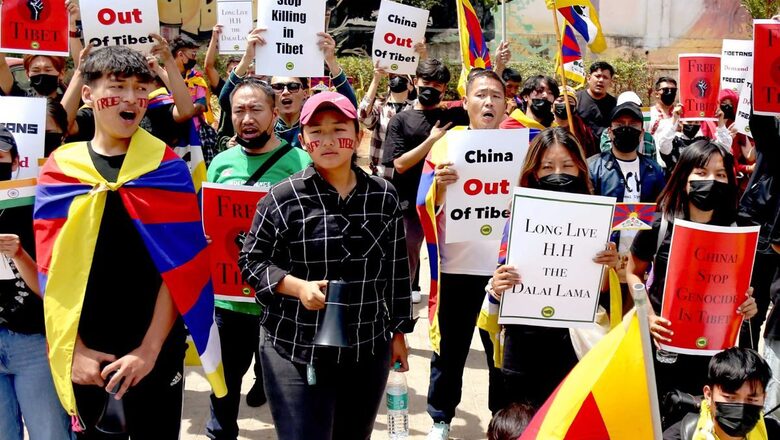
views
February 13, 2024, marked 111 years of Tibetan Independence Day celebrated mostly by Tibetans living in exile around the world. The People’s Republic of China (PRC) which maintains the position that Tibet has historically been an integral part of China denounces this day as ‘fabricated’. The contestation with respect to sovereignty is essentially rooted in Tibetan history, which is interpreted differently by the Tibetans and the PRC.
Historians and scholars tend to differ on the question of Tibet’s sovereignty prior to 1912, the year of the fall of the Qing dynasty in China. While some believe that Tibet did not possess complete sovereignty, others are of the opinion that Tibet remained independent with foreign entities such as Mongols, British, Chinese and Nepalese retaining occasional suzerainty over Tibet in different periods. The history texts however highlight that when Tibet was under the spiritual leadership of the 13th Dalai Lama (also known as Thubten Gyasto), it witnessed two invasions; first, by the British expedition forces in 1904 and second, by the Manchus (Qing) in 1910. Both times, the 13th Dalai Lama was forced to flee Lhasa (Tibet) to seek exile in Mongolia and the British protectorate in India respectively.
A Treaty of Convention between Britain and Tibet was subsequently signed following the 1904 invasion whereby the former ensured non-intervention by any foreign powers in Tibetan affairs without the consent of the British government and confirmed Tibet’s boundary and trading rights, among other things. Two years later, Britain signed another Treaty of Convention with China respecting Tibet whereby the former agreed to not annex Tibetan territory or interfere in its administration, while the latter undertook to not permit interference of any other foreign state in Tibetan territory or in its internal administration. These two conventions are significant as they both reiterate Tibet’s existence as a sovereign entity and China’s suzerainty over Tibet, contested by the PRC after 1950. During his second exile, the Dalai Lama was proclaimed deposed by the Qing rule in 1910.
Presently, Tibetan Independence Day is observed as the day the 13th Dalai Lama proclaimed the independence of Tibet in 1913 following his return to Lhasa from his exile in India the previous year. In this declaration, the Dalai Lama stated, “Tibet is an independent nation living in peace and in accordance with its religion. We are a small, religious and independent nation.” He further claimed that historically, Tibet had no Qing (Manchu) or Chinese authority in the region, a clear indication of Tibet’s complete sovereignty to have existed historically. The Qing dynasty, who were not Chinese rulers, exercised only political control over Tibet as a protectorate state, which de facto ended with the collapse of the Qing dynasty in 1912.
As per historical records, the Republic of China was established in 1912 with the fall of the Qing dynasty, ending China’s last imperial dynasty following the Xinhai Revolution of 1911. The new head of the Chinese State sought to establish cordial relations with Tibet and offered to restore the Dalai Lama to his previous position. However, the Dalai Lama refused the Title, declared Tibet independent in 1913 and standardised the Tibetan flag in its present form, seen to be in use by the Tibetan government-in-exile (in Dharamshala, India).
The Mongol-Tibet Treaty of Friendship and Alliance was concluded the same year which mentions their freedom from the Qing dynasty, their separation from China and the formation of their own independent states. The treaty’s authenticity is contested by the PRC, claiming it to be a tool for Russian intervention in Tibet and therefore, considers it to be invalid. However, the treaty was proclaimed by Tibetans as another indication of Tibet’s sovereignty before 1951 which witnessed the assimilation of Tibet into China as per the Seventeen-Point Agreement.
The return of the Dalai Lama witnessed him assuming political as well as spiritual leadership of Tibet that the independent reign continued for four decades till 1951. The modernisation of Tibet was initiated under his reign which saw an independent Tibet maintaining its own army and government, use of its own language and currency, trade missions with foreign countries and regulated movement across borders. The 13th Dalai Lama is also recognised to be the first one to make formal international agreements as a sovereign nation.
However, the assimilation of Tibet under China after 1951 is the result of China’s aggressive policy as witnessed in the Battle of Chamdo (1950), the Seventeen-Point Agreement (1951) later renounced by the 14th and current Dalai Lama, claiming to be signed under duress, as PRC broke its promise of respecting Tibet’s autonomy. The agreement remains to be the only one concluded by the PRC with a minority group. Post 1950, China or PRC, interprets history differently in an effort to claim its ‘historical’ assertion over Tibetan land. According to the PRC, Tibet has historically been part of China, coming under the jurisdiction of the Central government since the Yuan dynasty (1271-1368).
Post 1950, Chinese annexation of Tibet paved the way for its aggressive onslaught on Tibetans, leading to mass exile and persecution, occupation of naïve land, exploitation of resources and imposition of Sinicization in its effort to erode Tibet’s unique cultural, linguistic and religious identity.
While Beijing denounces marking of Tibetan Independence Day as a ‘farce’, the very observation and celebration of this day among the Tibetan community living in exile, 111 years since its declaration, speak volumes of Tibetans’ assertion of keeping their identity alive and rejection of China’s ongoing attempts at eroding Tibetan’s sovereign existence.
The writer is an author and columnist and has written several books. His X handle is @ArunAnandLive. Views expressed in the above piece are personal and solely that of the author. They do not necessarily reflect News18’s views.
















Comments
0 comment